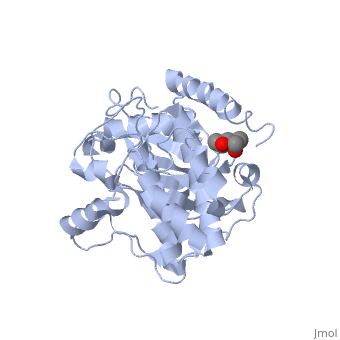1j3h
Crystal structure of apoenzyme cAMP-dependent protein kinase catalytic subunitCrystal structure of apoenzyme cAMP-dependent protein kinase catalytic subunit
Structural highlights
FunctionKAPCA_MOUSE Phosphorylates a large number of substrates in the cytoplasm and the nucleus. Regulates the abundance of compartmentalized pools of its regulatory subunits through phosphorylation of PJA2 which binds and ubiquitinates these subunits, leading to their subsequent proteolysis. Phosphorylates CDC25B, ABL1, NFKB1, CLDN3, PSMC5/RPT6, PJA2, RYR2, RORA, TRPC1 and VASP. RORA is activated by phosphorylation. Required for glucose-mediated adipogenic differentiation increase and osteogenic differentiation inhibition from osteoblasts. Involved in the regulation of platelets in response to thrombin and collagen; maintains circulating platelets in a resting state by phosphorylating proteins in numerous platelet inhibitory pathways when in complex with NF-kappa-B (NFKB1 and NFKB2) and I-kappa-B-alpha (NFKBIA), but thrombin and collagen disrupt these complexes and free active PRKACA stimulates platelets and leads to platelet aggregation by phosphorylating VASP. Prevents the antiproliferative and anti-invasive effects of alpha-difluoromethylornithine in breast cancer cells when activated. RYR2 channel activity is potentiated by phosphorylation in presence of luminal Ca(2+), leading to reduced amplitude and increased frequency of store overload-induced Ca(2+) release (SOICR) characterized by an increased rate of Ca(2+) release and propagation velocity of spontaneous Ca(2+) waves, despite reduced wave amplitude and resting cytosolic Ca(2+). TRPC1 activation by phosphorylation promotes Ca(2+) influx, essential for the increase in permeability induced by thrombin in confluent endothelial monolayers. PSMC5/RPT6 activation by phosphorylation stimulates proteasome. Regulates negatively tight junction (TJs) in ovarian cancer cells via CLDN3 phosphorylation. NFKB1 phosphorylation promotes NF-kappa-B p50-p50 DNA binding. Involved in embryonic development by down-regulating the Hedgehog (Hh) signaling pathway that determines embryo pattern formation and morphogenesis. Isoform 2 phosphorylates and activates ABL1 in sperm flagellum to promote spermatozoa capacitation. Prevents meiosis resumption in prophase-arrested oocytes via CDC25B inactivation by phosphorylation. May also regulate rapid eye movement (REM) sleep in the pedunculopontine tegmental (PPT).[1] [2] [3] Evolutionary ConservationCheck, as determined by ConSurfDB. You may read the explanation of the method and the full data available from ConSurf. Publication Abstract from PubMedTo better understand the mechanism of ligand binding and ligand-induced conformational change, the crystal structure of apoenzyme catalytic (C) subunit of adenosine-3',5'-cyclic monophosphate (cAMP)-dependent protein kinase (PKA) was solved. The apoenzyme structure (Apo) provides a snapshot of the enzyme in the first step of the catalytic cycle, and in this unliganded form the PKA C subunit adopts an open conformation. A hydrophobic junction is formed by residues from the small and large lobes that come into close contact. This "greasy" patch may lubricate the shearing motion associated with domain rotation, and the opening and closing of the active-site cleft. Although Apo appears to be quite dynamic, many important residues for MgATP binding and phosphoryl transfer in the active site are preformed. Residues around the adenine ring of ATP and residues involved in phosphoryl transfer from the large lobe are mostly preformed, whereas residues involved in ribose binding and in the Gly-rich loop are not. Prior to ligand binding, Lys72 and the C-terminal tail, two important ATP-binding elements are also disordered. The surface created in the active site is contoured to bind ATP, but not GTP, and appears to be held in place by a stable hydrophobic core, which includes helices C, E, and F, and beta strand 6. This core seems to provide a network for communicating from the active site, where nucleotide binds, to the peripheral peptide-binding F-to-G helix loop, exemplified by Phe239. Two potential lines of communication are the D helix and the F helix. The conserved Trp222-Phe238 network, which lies adjacent to the F-to-G helix loop, suggests that this network would exist in other protein kinases and may be a conserved means of communicating ATP binding from the active site to the distal peptide-binding ledge. Dynamic features of cAMP-dependent protein kinase revealed by apoenzyme crystal structure.,Akamine P, Madhusudan, Wu J, Xuong NH, Ten Eyck LF, Taylor SS J Mol Biol. 2003 Mar 14;327(1):159-71. PMID:12614615[4] From MEDLINE®/PubMed®, a database of the U.S. National Library of Medicine. See AlsoReferences
|
| ||||||||||||||||||
